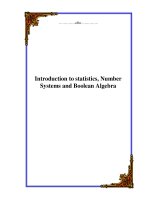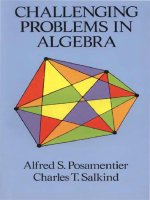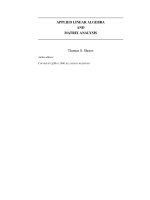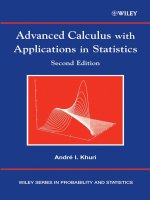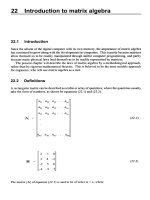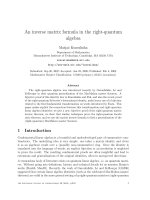Matrix algebra statistics 2e andre khuri searle
Bạn đang xem bản rút gọn của tài liệu. Xem và tải ngay bản đầy đủ của tài liệu tại đây (24.56 MB, 665 trang )
www.pdfgrip.com
WILEY SERIES IN PROBABILITY AND STATISTICS
Established by Walter A. Shewhart and Samuel S. Wilks
Editors: David J. Balding, Noel A. C. Cressie, Garrett M. Fitzmaurice,
Geof H. Givens, Harvey Goldstein, Geert Molenberghs, David W. Scott,
Adrian F. M. Smith, Ruey S. Tsay
Editors Emeriti: J. Stuart Hunter, Iain M. Johnstone, Joseph B. Kadane,
Jozef L. Teugels
The Wiley Series in Probability and Statistics is well established and authoritative. It
covers many topics of current research interest in both pure and applied statistics and
probability theory. Written by leading statisticians and institutions, the titles span both
state-of-the-art developments in the field and classical methods.
Reflecting the wide range of current research in statistics, the series encompasses
applied, methodological and theoretical statistics, ranging from applications and new
techniques made possible by advances in computerized practice to rigorous treatment
of theoretical approaches. This series provides essential and invaluable reading for all
statisticians, whether in academia, industry, government, or research.
A complete list of titles in this series can be found at />This eBook was posted by AlenMiler on AvaxHome!
Many New eBooks in my Blog: />Mirror: />
www.pdfgrip.com
www.pdfgrip.com
Matrix Algebra Useful for Statistics
www.pdfgrip.com
Second Edition
Shayle R. Searle
André I. Khuri
www.pdfgrip.com
Copyright © 2017 by John Wiley & Sons, Inc. All rights reserved.
Published by John Wiley & Sons, Inc., Hoboken, New Jersey.
Published simultaneously in Canada.
No part of this publication may be reproduced, stored in a retrieval system, or transmitted in any form or by any means,
electronic, mechanical, photocopying, recording, scanning, or otherwise, except as permitted under Section 107 or 108 of
the 1976 United States Copyright Act, without either the prior written permission of the Publisher, or authorization
through payment of the appropriate per-copy fee to the Copyright Clearance Center, Inc., 222 Rosewood Drive, Danvers,
MA 01923, (978) 750-8400, fax (978) 750-4470, or on the web at www.copyright.com. Requests to the Publisher for
permission should be addressed to the Permissions Department, John Wiley & Sons, Inc., 111 River Street, Hoboken, NJ
07030, (201) 748-6011, fax (201) 748-6008, or online at />Limit of Liability/Disclaimer of Warranty: While the publisher and author have used their best efforts in preparing this
book, they make no representations or warranties with respect to the accuracy or completeness of the contents of this
book and specifically disclaim any implied warranties of merchantability or fitness for a particular purpose. No warranty
may be created or extended by sales representatives or written sales materials. The advice and strategies contained herein
may not be suitable for your situation. Y ou should consult with a professional where appropriate. Neither the publisher
nor author shall be liable for any loss of profit or any other commercial damages, including but not limited to special,
incidental, consequential, or other damages.
For general information on our other products and services or for technical support, please contact our Customer Care
Department within the United States at (800) 762-2974, outside the United States at (317) 572-3993 or fax (317) 5724002.
Wiley also publishes its books in a variety of electronic formats. Some content that appears in print may not be available
in electronic formats. For more information about Wiley products, visit our web site at www.wiley.com.
Library of Congress Cataloging-in-Publication Data is available.
ISBN: 978-1-118-93514-9
www.pdfgrip.com
In Memory of Shayle R. Searle, a Good Friend and Colleague
To My Faithful Wife, Ronnie, and Dedicated Children, Marcus and Roxanne, and Their
Families
www.pdfgrip.com
www.pdfgrip.com
CONTENTS
PREFACE
PREFACE TO THE FIRST EDITION
INTRODUCTION
ABOUT THE COMPANION WEBSITE
PART I DEFINITIONS, BASIC CONCEPTS, AND MATRIX OPERATIONS
1 Vector Spaces, Subspaces, and Linear Transformations
1.1 Vector Spaces
1.2 Base of a Vector Space
1.3 Linear Transformations
Reference
Exercises
2 Matrix Notation and Terminology
2.1 Plotting of a Matrix
2.2 Vectors and Scalars
2.3 General Notation
Exercises
3 Determinants
3.1 Expansion by Minors
3.2 Formal Definition
3.3 Basic Properties
3.4 Elementary Row Operations
3.5 Examples
3.6 Diagonal Expansion
3.7 The Laplace Expansion
3.8 Sums and Differences of Determinants
3.9 A Graphical Representation of a 3 × 3 Determinant
References
Exercises
Notes
4 Matrix Operations
4.1 The Transpose of a Matrix
4.2 Partitioned Matrices
4.3 The Trace of a Matrix
www.pdfgrip.com
4.4 Addition
4.5 Scalar Multiplication
4.6 Equality and the Null Matrix
4.7 Multiplication
4.8 The Laws of Algebra
4.9 Contrasts With Scalar Algebra
4.10 Direct Sum of Matrices
4.11 Direct Product of Matrices
4.12 The Inverse of a Matrix
4.13 Rank of a Matrix—Some Preliminary Results
4.14 The Number of LIN Rows and Columns in a Matrix
4.15 Determination of The Rank of a Matrix
4.16 Rank and Inverse Matrices
4.17 Permutation Matrices
4.18 Full-Rank Factorization
References
Exercises
5 Special Matrices
5.1 Symmetric Matrices
5.2 Matrices Having all Elements Equal
5.3 Idempotent Matrices
5.4 Orthogonal Matrices
5.5 Parameterization of Orthogonal Matrices
5.6 Quadratic Forms
5.7 Positive Definite Matrices
References
Exercises
6 Eigenvalues and Eigenvectors
6.1 Derivation of Eigenvalues
6.2 Elementary Properties of Eigenvalues
6.3 Calculating Eigenvectors
6.4 The Similar Canonical Form
6.5 Symmetric Matrices
6.6 Eigenvalues of orthogonal and Idempotent Matrices
www.pdfgrip.com
6.7 Eigenvalues of Direct Products and Direct Sums of Matrices
6.8 Nonzero Eigenvalues of AB and BA
References
Exercises
Notes
7 Diagonalization of Matrices
7.1 Proving the Diagonability Theorem
7.2 Other Results for Symmetric Matrices
7.3 The Cayley–Hamilton Theorem
7.4 The Singular-Value Decomposition
References
Exercises
8 Generalized Inverses
8.1 The Moore–Penrose Inverse
8.2 Generalized Inverses
8.3 Other Names and Symbols
8.4 Symmetric Matrices
References
Exercises
9 Matrix Calculus
9.1 Matrix Functions
9.2 Iterative Solution of Nonlinear Equations
9.3 Vectors of Differential Operators
9.4 Vec and Vech Operators
9.5 Other Calculus Results
9.6 Matrices With Elements That Are Complex Numbers
9.7 Matrix Inequalities
References
Exercises
Notes
PART II APPLICATIONS OF MATRICES IN STATISTICS
10 Multivariate Distributions and Quadratic Forms
10.1 Variance-Covariance Matrices
10.2 Correlation Matrices
www.pdfgrip.com
10.3 Matrices of Sums of Squares and Cross-Products
10.4 The Multivariate Normal Distribution
10.5 Quadratic Forms and χ2-Distributions
10.6 Computing the Cumulative Distribution Function of a Quadratic Form
References
Exercises
11 Matrix Algebra of Full-Rank Linear Models
11.1 Estimation of β by the Method of Least Squares
11.2 Statistical Properties of the Least-Squares Estimator
11.3 Multiple Correlation Coefficient
11.4 Statistical Properties Under the Normality Assumption
11.5 Analysis of Variance
11.6 The Gauss–Markov Theorem
11.7 Testing Linear Hypotheses
11.8 Fitting Subsets of the x-Variables
11.9 The use of the R(.|.) Notation in Hypothesis Testing
References
Exercises
12 Less-Than-Full-Rank Linear Models
12.1 General Description
12.2 The Normal Equations
12.3 Solving the Normal Equations
12.4 Expected values and variances
12.5 Predicted y-Values
12.6 Estimating the Error Variance
12.7 Partitioning the Total Sum of Squares
12.8 Analysis of Variance
12.9 The R( · | · ) Notation
12.10 Estimable Linear Functions
12.11 Confidence Intervals
12.12 Some Particular Models
12.13 The R( · | ·) Notation (continued)
12.14 Reparameterization to a Full-Rank Model
References
www.pdfgrip.com
Exercises
13 Analysis of Balanced Linear Models Using Direct Products of Matrices
13.1 General Notation for Balanced Linear Models
13.2 Properties Associated with Balanced Linear Models
13.3 Analysis of Balanced Linear Models
References
Exercises
14 Multiresponse Models
14.1 Multiresponse Estimation of Parameters
14.2 Linear Multiresponse Models
14.3 Lack of Fit of a Linear Multiresponse Model
References
Exercises
PART III MATRIX COMPUTATIONS AND RELATED SOFTWARE
15 SAS/IML
15.1 Getting Started
15.2 Defining a Matrix
15.3 Creating a Matrix
15.4 Matrix Operations
15.5 Explanations of SAS Statements Used Earlier in the Text
References
Exercises
16 Use of MATLAB in Matrix Computations
16.1 Arithmetic Operators
16.2 Mathematical Functions
16.3 Construction of Matrices
16.4 Two- and Three-Dimensional Plots
References
Exercises
17 Use of R in Matrix Computations
17.1 Two- and Three-Dimensional Plots
References
Exercises
APPENDIX SOLUTIONS TO EXERCISES
www.pdfgrip.com
Chapter 1
Chapter 2
Chapter 3
Chapter 4
Chapter 5
Chapter 6
Chapter 7
Chapter 8
Chapter 9
Chapter 10
Chapter 11
Chapter 12
Chapter 13
Chapter 14
Chapter 15
Chapter 16
Chapter 17
INDEX
EULA
www.pdfgrip.com
List of Tables
Chapter 4
Table 4.1
Table 4.2
Chapter 9
Table 9.1
Chapter 10
Table 10.1
Table 10.2
Chapter 11
Table 11.1
Table 11.2
Table 11.3
Table 11.4
Table 11.5
Table 11.6
Table 11.7
Table 11.8
Table 11.9
Table 11.10
Table 11.11
Chapter 12
Table 12.1
Table 12.2
Table 12.3
Table 12.4
Table 12.5
Table 12.6
Table 12.8
Table 12.9
www.pdfgrip.com
Table 12.10
Table 12.11
Table 12.12
Table 12.13
Chapter 13
Table 13.1
Table 13.2
Table 13.3
Table 13.4
Table 13.5
Table 13.6
Table 13.7
Table 13.8
Table 13.9
Chapter 14
Table 14.1
Chapter 15
Table 15.1
Chapter 16
Table 16.1
Table 16.2
Chapter 17
Table 17.1
www.pdfgrip.com
List of Illustrations
Introduction
Figure 0.1 A Cuneiform Tablet with 97 Linear Equations (YBC4695-1). Yale
Babylonian Collection, Yale University Library, New Haven, CT.
Figure 0.2 An Old Babylonian Mathematical Text with Linear Equations
(YBC4695-2). Yale Babylonian Collection, Yale University Library, New Haven, CT.
Chapter 1
Figure 1.1 (a) Two-Dimensional and (b) Three-Dimensional Euclidean Spaces.
Chapter 2
Figure 2.1 Plot of Matrix
.
Figure 2.2 Plot of a 4 × 4 Identity Matrix.
Chapter 3
Figure 3.1 Parallelpiped Constructed from the Vectors , , .
Chapter 6
Figure 6.1 The Matrix
with Its Eigenvalue λ and Eigenvector
Figure 6.2 A Scatter Plot of Eigenvalues of a Matrix of Order 50 × 50.
Chapter 11
Figure 11.1 Geometric Representation of Least Squares Estimation.
Figure 11.2 Plot of Weight and Predicted Weight Values.
Figure 11.3 Fit Plot for Weight with Confidence and Prediction Limits.
Chapter 15
Figure 15.1 Plot of Residuals Versus x.
Figure 15.2 Plot of Predicted Versus x.
Figure 15.3 Plot of Residual Versus Predicted Values.
Figure 15.4 Plot of Residuals Versus x1.
Figure 15.5 Plot of Residuals Versus x2.
Figure 15.6 Plot of Yield Versus Predicted Values.
Figure 15.7 Studentized Residuals and Cook’s D for Yield.
Chapter 16
Figure 16.1 Plot of x and y Vectors.
www.pdfgrip.com
Figure 16.2 Plot of Cosine Function.
Figure 16.3 Plot of Two Polynomial Functions.
Figure 16.4 Plot of the Matrix M.
Figure 16.5 Plot of Eigenvalues of a
Figure 16.6 Curves in a Three-Dimensional Space.
Figure 16.7 Surf Applied to Matrix A.
Figure 16.8 A Mesh Plot.
Figure 16.9 Mesh-Contour of Matrix A.
Chapter 17
Figure 17.1 The Yield Data Fitted to a Straight Line.
Figure 17.2 Plot of the Ellipse x2 + 2y2 = 1.
Figure 17.3 Boxplots for the Two Orchards.
Figure 17.4 Plot of the Two Functions.
Figure 17.5 Histogram with the Normal Density Curve.
Figure 17.6 The Fertilizers’ Interaction Plot.
Figure 17.7 A Plot of a Correlation Matrix.
Figure 17.8 Q-Q Plot for the Normal Distribution.
Figure 17.9 Q-Q Plot for the Lognormal Distribution.
Figure 17.10 A Quadratic Response Surface.
Figure 17.11 Contour Plots of a Response Surface.
Figure 17.12 A Three-Dimensional Scatter Plot.
Appendix
Figure 1 Plot of the Residuals Against the Regressors.
Figure 2 Plot of the Residuals Against the Predicted Values.
Figure 3 Plot of Normal Quantiles.
Figure 4 Plot of the y Function.
Figure 5 Plot of the z Function.
Figure 6 Plot of the Trigonometric Function.
Figure 7 Plot of a Three-Dimensional Figure.
www.pdfgrip.com
www.pdfgrip.com
Preface
The primary objective of the second edition is to update the material in the first edition.
This is a significant undertaking given that the first edition appeared in 1982. It should be
first pointed out that this is more than just an update. It is in fact a major revision of the
material affecting not only its presentation, but also its applicability and use by the
reader.
The second edition consists of three parts. Part I is comprised of Chapters 1–9, which
with the exception of Chapter 1, covers material based on an update of Chapters 1–12 in
the first edition. These chapters are preceded by an introductory chapter giving historical
perspectives on matrix algebra. Chapter 1 is new. It discusses vector spaces and linear
transformations that represent an introduction to matrices. Part II addresses applications
of matrices in statistics. It consists of Chapters 10–14. Chapters 10–11 constitute an
update of Chapters 13–14 in the first edition. Chapter 12 is similar to Chapter 15 in the
first edition. It covers models that are less than full rank. Chapter 13 is entirely new. It
discusses the analysis of balanced linear models using direct products of matrices.
Chapter 14 is also a new addition that covers multiresponse linear models where several
responses can be of interest. Part III is new. It covers computational aspects of matrices
and consists of three chapters. Chapter 15 is on the use of SAS/IML, Chapter 16 covers the
use of MATLAB, and Chapter 17 discusses the implementation of R in matrix
computations. These three chapters are self-contained and provide the reader with the
necessary tools to carry out all the computations described in the book. The reader can
choose whichever software he/she feels comfortable with. It is also quite easy to learn
new computational techniques that can be beneficial.
The second edition displays a large number of figures to illustrate certain computational
details. This provides a visual depiction of matrix entities such as the plotting of a matrix
and the graphical representation of a determinant. In addition, many examples have been
included to provide a better understanding of the material.
A new feature in the second edition is the addition of detailed solutions to all the oddnumbered exercises. The even-numbered solutions will be placed online by the publisher.
This can be helpful to the reader who desires to use the book as a source for learning
matrix algebra.
As with the first edition, the second edition emphasizes the “bringing to a broad spectrum
of readers a knowledge of matrix algebra that is useful in the statistical analysis of data
and in statistics in general.” The second edition should therefore appeal to all those who
desire to gain a better understanding of matrix algebra and its applications in linear
models and multivariate statistics. The computing capability that the reader needs is
particularly enhanced by the inclusion of Part III on matrix computations.
I am grateful to my wife Ronnie, my daughter Roxanne, and son Marcus for their support
and keeping up with my progress in writing the book over the past 3 years. I am also
grateful to Steve Quigley, a former editor with John Wiley & Sons, for having given me
www.pdfgrip.com
the opportunity to revise the first edition. Furthermore, my gratitude goes to Julie Platt,
an Editor-in-Chief with the SAS Institute, for allowing me to use the SAS software in the
second edition for two consecutive years.
ANDRÉ I. KHURI
Jacksonville, Florida
January 2017
www.pdfgrip.com
www.pdfgrip.com
Preface to the First Edition
Algebra is a mathematical shorthand for language, and matrices are a shorthand for
algebra. Consequently, a special value of matrices is that they enable many mathematical
operations, especially those arising in statistics and the quantitative sciences, to be
expressed concisely and with clarity. The algebra of matrices is, of course, in no way new,
but its presentation is often so surrounded by the trappings of mathematical generality
that assimilation can be difficult for readers who have only limited ability or training in
mathematics. Yet many such people nowadays find a knowledge of matrix algebra
necessary for their work, especially where statistics and/or computers are involved. It is
to these people that I address this book, and for them, I have attempted to keep the
mathematical presentation as informal as possible.
The pursuit of knowledge frequently involves collecting data, and those responsible for
the collecting must appreciate the need for analyzing their data to recover and interpret
the information contained therein. Such people must therefore understand some of the
mathematical tools necessary for this analysis, to an extent either that they can carry out
their own analysis, or that they can converse with statisticians and mathematicians whose
help will otherwise be needed. One of the necessary tools is matrix algebra. It is becoming
as necessary to science today as elementary calculus has been for generations. Matrices
originated in mathematics more than a century ago, but their broad adaptation to science
is relatively recent, prompted by the widespread acceptance of statistical analysis of data,
and of computers to do that analysis; both statistics and computing rely heavily on matrix
algebra. The purpose of this book is therefore that of bringing to a broad spectrum of
readers a knowledge of matrix algebra that is useful in the statistical analysis of data and
in statistics generally.
The basic prerequisite for using the book is high school algebra. Differential calculus is
used on only a few pages, which can easily be omitted; nothing will be lost insofar as a
general understanding of matrix algebra is concerned. Proofs and demonstrations of most
of the theory are given, for without them the presentation would be lifeless. But in every
chapter the theoretical development is profusely illustrated with elementary numerical
examples and with illustrations taken from a variety of applied sciences. And the last
three chapters are devoted solely to uses of matrix algebra in statistics, with Chapters 14
and 15 outlining two of the most widely used statistical techniques: regression and linear
models.
The mainstream of the book is its first 11 chapters, beginning with one on introductory
concepts that includes a discussion of subscript and summation notation. This is followed
by four chapters dealing with basic arithmetic, special matrices, determinants and
inverses. Chapters 6 and 7 are on rank and canonical forms, 8 and 9 deal with generalized
inverses and solving linear equations, 10 is a collection of results on partitioned matrices,
and 11 describes eigenvalues and eigenvectors. Background theory for Chapter 11 is
collected in an appendix, Chapter 11A, some summaries and miscellaneous topics make
up Chapter 12, statistical illustrations constitute Chapter 13, and Chapters 14 and 15
www.pdfgrip.com
describe regression and linear models. All chapters except the last two end with exercises.
Occasional sections and paragraphs can be omitted at a first reading, especially by those
whose experience in mathematics is somewhat limited. These portions of the book are
printed in small type and, generally speaking, contain material subsidiary to the main
flow of the text—material that may be a little more advanced in mathematical
presentation than the general level otherwise maintained.
Chapters, and sections within chapters, are numbered with Arabic numerals 1, 2, 3,…
Within-chapter references to sections are by section number, but references across
chapters use the decimal system, for example, Section 1.3 is Section 3 of Chapter 1. These
numbers are also shown in the running head of each page, for example, [1.3] is found on
page 4. Numbered equations are (1), (2),…, within each chapter. Those of one chapter are
seldom referred to in another, but when they are, the chapter reference is explicit;
otherwise “equation (3)” or more simply “(3)” means the equation numbered (3) in the
chapter concerned. Exercises are in unnumbered sections and are referenced by their
chapter number; for example, Exercise 6.2 is Exercise 2 at the end of Chapter 6.
I am greatly indebted to George P. H. Styan for his exquisitely thorough readings of two
drafts of the manuscript and his extensive and very helpful array of comments. Harold V.
Henderson’s numerous suggestions for the final manuscript were equally as helpful.
Readers of Matrix Algebra for the Biological Sciences (Wiley, 1966), and students in 15
years of my matrix algebra course at Cornell have also contributed many useful ideas.
Particular thanks go to Mrs. Helen Seamon for her superb accuracy on the typewriter,
patience, and fantastic attention to detail; such attributes are greatly appreciated.
SHAYLE R. SEARLE
Ithaca, New York
May 1982
www.pdfgrip.com
